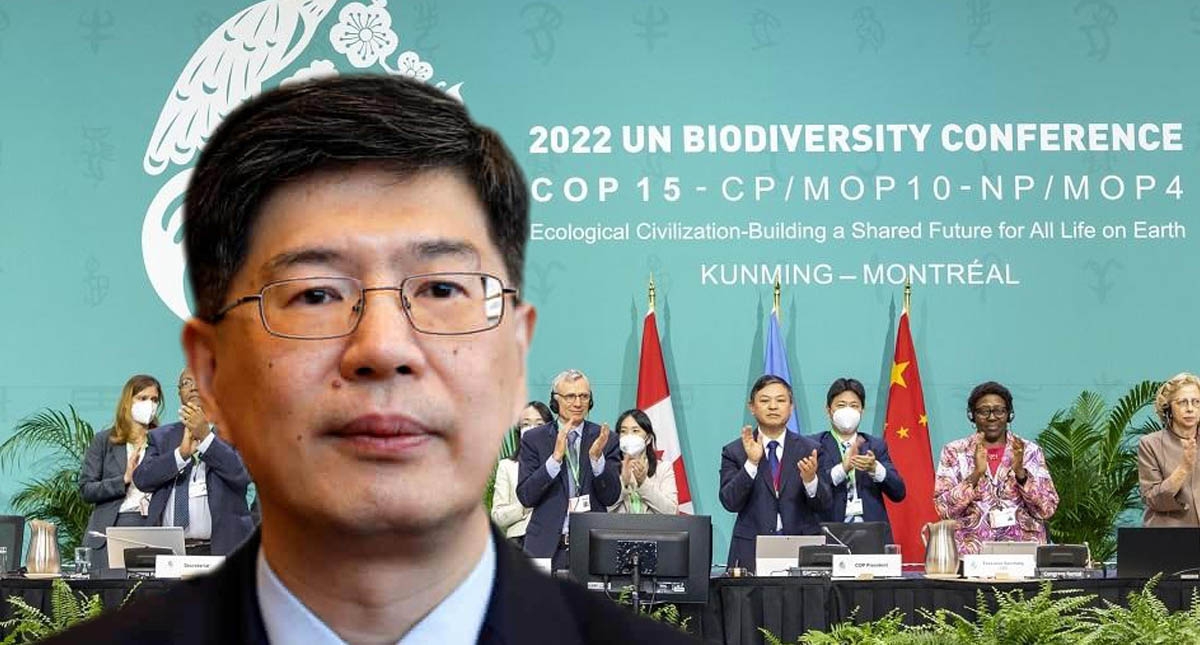
China’s Ambassador to Canada, Cong Peiwu, Discusses COP15 and Canada-China Relations Amid 2023
“In its role as President of COP15, China successfully fulfilled its mandate, working together with Canada and all the other parties to bring the conference to a success.”
OTTAWA, Dec 22—In an exclusive interview with Ottawa Life Magazine, Ambassador Cong Peiwu discussed key outcomes following the Kunming-Montreal Global Biodiversity Framework (GBF) at the 15th Conference of the Parties (COP15) to the United Nations (UN) Convention on Biological Diversity. The two-week summit was held in Montreal from December 7-19, 2022, bringing together delegates from 196 countries to finalize a robust GBF.
Ambassador Cong said the GBF reached in Montreal is ambitious yet pragmatic and balanced. Firstly, it is a commitment by all 196 parties to conserve at least 30 percent of the earth's land and ocean by 2030. Secondly, the GBF pledges to increase the annual financial aid developed countries provide to developing countries in support of biodiversity conservation, according to Cong.
When asked how the agreement will be enforced and what role China will play in implementing the framework, Cong stated that it is first important to have a solid foundation. That is why the Chinese delegation worked hard with all other parties to ensure there were concrete deliverables by the end of the conference. Thus, according to the Ambassador, the GBF is a critical first step that lays a solid foundation for global collaboration on biodiversity protection.
Cong also underscored China’s firm commitment to support developing countries with biodiversity conservation and climate change mitigation. For instance, he cited Chinese President Xi Jinping’s pledge to set up a Kunming fund on Biodiversity Protection for Developing Countries during the first round of COP15 in 2021. Subsequently, the first funding proposal totaled ¥1.5 billion RMB, approximately $300 million CAD. In addition to funding, he noted that China is already helping countries in the global south by training personnel and providing necessary materials targeting environmental conservation.
Ambassador Cong emphasized that China is still a developing country in the process of industrialization. Given this, it is particularly challenging for Beijing to meet international targets and provide on the ground support for other developing nations. That said, China is a country that when it pledges to something, it takes all efforts to ensure that goal is realized, said the Ambassador. At the same time, he expressed his agreement with remarks made by UN Secretary-General António Guterres at the conference regarding the additional responsibility developed countries must assume in raising public and private funds for developing countries. Nonetheless, Cong stressed that China is prepared to further its contributions and engage in cooperation with Canada and other members of the international community on critical transnational issues regardless.
When asked about whether collaborative efforts seen during COP15 could be carried over into other areas such as global public health, trade, and technology transfers, Ambassador Cong observed the constructive diplomacy in Montreal sets up a fine example for future cooperation between Canada and China and the international at large. He contended that Canada-China relations require us to look ahead and bear in mind the mutual interests of our countries. The Ambassador said he hopes both countries will continue working together to remove obstacles and create the right conditions to further collaborative efforts on transnational issues.
“We hope the Canadian side will work hard with the Chinese side to move the relationship back to normalcy so we can do things that our conducive to our people and the entire world.”
Read the full interview with Ambassador Cong Peiwu
EXCLUSIVE INTERVIEW WITH AMBASSADOR CONG PEIWU: COP15 MONTREAL 2022
Ambassador Cong Peiwu: The second part of COP15 was held in Montreal recently and it was quite a successful event. The most significant outcome of the conference was the Kunming-Montreal global biodiversity framework (GBF), as we call it. The GBF is ambitious, pragmatic, and balanced. It sets targets and commitments that are acceptable to all parties. It also identifies targets and pathways for global biodiversity protection. It sets an example of cooperation for the international community. The GBF has historically dedicated its vision to 2050 of living in harmony with nature. It has historically incorporated the Digital Secrets Information (DSI) lending power and has historically decided to establish a framework. The GBF is a commitment by all 196 parties to conserve at least 30 percent of the earth's land and ocean by 2030. It also will increase the expected annual financial assistance by developed countries to help developing nations with biodiversity protection. China has long attached significant importance to biodiversity protection and actively engaging in international cooperation. Like Canada, China was among the first countries to become a party to the convention on biodiversity protection. And, as president of the COP15, China successfully fulfilled its mandate, working together with Canada and all the other parties to bring the conference to a success. This is featured by GBF. As Chinese President Xi Jinping said in his speech during the conference, “Some ecosystems are essential for the prosperity of civilization. We must work together to promote harmonious co-existence between man and nature. Build a community of all life on the earth. And create a clean and beautiful world for us all.” Looking forward, we will continue to preserve the ecological system, and maintain harmony between humanity and nature when planning our development to continuously enhance diversity, stability, and sustainability in our ecosystems. All parties, we believe, should also continue to work together to inject new strength and momentum into global biodiversity protection.
Ottawa Life Magazine (OLM): As you noted in your opening remarks Ambassador Cong, one of the most significant components of the agreement is the commitment to protect 30 percent of earth’s land and sea areas by 2030, which is a stark contrast with the former approach that protects only 17 percent of terrestrial areas and 10 percent marine. Given this, when conference participants use the language ‘protected’ that infers some institution or body will be protecting these areas in the future in accordance with the newly established targets. Can you comment on how that process will work? Specifically, who will adjudicate the process? Who will pay for it? Where does China come into the equation?
Ambassador Cong Peiwu: It is important to have a framework and foundation for our future world. That is important, and that does not happen easily. Not only the Chinese delegation worked hard, but all parties concerned worked day and night to ensure we had the deliverables toward the end of the conference. The framework is there, but it is only the first step. It is important to make sure we follow through on all those commitments. According to the GBF, countries at the conference developed a roadmap that pledged to protect at least 30 percent of the earth's land and ocean by 2030. So, it is ambitious but at the same time, it is balanced and practical. From a fiscal perspective, the annual assistance to developing countries for efforts to protect biodiversity will be gradually increased from less than $10 billion USD to $30 billion USD. That is a very significant feature of the outcome. The framework also points out that countries from the global north agree to scale up conservation funding for developing nations, small island states, as well as countries with economies in transition to at least $20 billion USD a year by 2025 and later to $30 billion USD a year by 2030. Additionally, by 2030, all parties will mobilize at least 200 million USD a year from public and private sources for biodiversity-related funding and phase out of reform subsidies that harm biodiversity by at least 500 billion USD a year. So, you can see that there are numbers and figures there, meaning there are already muscles to the framework. For China, we will be doing our best within our ability because we are still the largest developing country in the world. We pay close attention to and place high importance on biodiversity protection. Not only domestically but also internationally, we are doing our best to support developing countries. When the first part of COP15 was held in Kunming, president Xi addressed the meeting through a video link. He proposed that China would set up a Kunming fund on biodiversity protection primarily aimed at developing countries. The first set of funding proposed totaled 1.5 billion RMB (approximately $215 million USD). Apart from funding, we are also helping countries in the south. We are training personnel and providing the necessary materials. We also believe biodiversity cannot be separated from climate change. Therefore, China is offering our support for developing countries in terms of coping with climate change, which is also an important part of our efforts. There are a lot of efforts on the Chinese side and concrete steps that are beyond COP15.
OLM: Apart from China’s support for biodiversity and climate change for developing countries in the global South, are there any other action targets on the ground in China that are seeking to prevent biodiversity loss? For example, funding for companies engaged in technologies that will support biodiversity, etc.
Ambassador Cong Peiwu: For us, we attach foremost importance to biodiversity protection and tackling climate change, and these two go together. For the past ten years, since the 18th national congress of the communist party of China was held in 2012, we have taken extraordinary efforts in this regard. President Xi Jinping himself emphasized on multiple occasions we should do our best to address this issue. For example, he emphasized that a civilization would thrive when its natural surroundings thrive. Likewise, our ancestors pointed out many years ago that harmony between nature and humans should be considered. That philosophy has been inherited by Chinese people today. At the same time, we value the integration of biodiversity protection, with China’s specific realities. As emphasized by President Xi Jinping, “China has made active efforts to promote ecological progress and diversity protection, stability, and sustainability of its ecosystems have kept improving. China has found a pathway of biodiversity protection with Chinese features.” Looking ahead, based on what we have achieved in the last ten years, there is still a lot of work for us to do. For example, the wild population of more than 30 hundred species of rare and engendered animals and plants in China have recovered and grown in the past ten years. That is a big step forward, but we need even more in the coming years. We have now written out several measures. For climate change, our ambitious plan is to have carbon dioxide peak by 2030 and carbon neutrality by 2060. That means it will only take China 30 years to have the transition from carbon peak to carbon neutrality. That is a huge challenge for us. It is extremely ambitious. For European countries it takes 70 years, and for the US, it takes more than 40 years. For China, a developing country that is still in the process of industrialization, it will not be easy to do this. However, China is a country that whenever we pledge something, we make all the efforts to realize our goal. That is why recently, we have been rolling out many action plans on construction, transportation, and infrastructure. We know these sectors tend to have high pollution, so we are carefully monitoring all those fronts to ensure pollution is reduced. When it comes to biodiversity, we are implementing a very forceful red-line system. We have already applied more than 30 percent of the red line to our land area, and it has already produced satisfactory results. We have also officially established the first batch of national parks; it came into force last year. The first batch consists of five national parks, which cover an area of more than 230 thousand square km. It is having a huge area stretching from Dongbei (northeast China) to the southern provinces of Sichuan and Hainan. Canada also has a long history of national parks. In this regard, I think that for Canada and China, we can step up our efforts in this regard in terms of national park systems. It can serve as one important part of our cooperation in biodiversity protection.
OLM: The agreement calls for raising $200 billion by 2030 for biodiversity from a range of sources and working to phase out or reform subsidies that could provide another $500 billion for nature. It also calls for increasing to at least $20 billion annually, and by 2025 that money will go to developing countries, and by 2030, the number will reach $30 billion. It is one thing, of course to call for raising money, but it is another to have the money and implement the agenda. . From your understanding Ambassador Cong, where is the money coming from, and how much will China commit in terms of real dollars to the program?
Ambassador Cong Peiwu: I recall UN Secretary-General António Gutteres mentioned developed countries must provide financial support to the global south since we cannot expect developing countries to shoulder the burden alone. As we can see, most regions with the richest yet most threatened biodiversity are in the global south. At the same time, these countries are often faced with the dilemma of destroying biodiversity to develop their economies. They are, therefore, most in need of funding. I think the developed countries should therefore shoulder more of the responsibility in raising funds from the public and private sectors. They can identify more channels to achieve funding. And for China, we are still a developing country however, among developing countries, China is the largest donor to the Global Environment Facility, the funding mechanism of the Conference of the Parties convention on biodiversity. China has fulfilled its responsibilities and obligations within its capacity. China is willing to make joint efforts with other countries to fulfill our commitments and proactively meet the targets to reverse the loss of biodiversity and safeguard the earth. This is an ongoing process. Montreal is one step in the right direction, and China is ready to make more contributions and engage in more cooperation with Canada and other members of the international community.
OLM: The framework also refers to synergistic conservation between biodiversity conservation and climate change mitigation and adaptation. China has attached great importance to biodiversity conservation and actively promoted COP15, which came after four years of "marathon" negotiations. Given China’s ample support for climate change and biodiversity protection, do you think this kind of dialogue we have seen between Canada and China can lead to constructive outcomes in other areas requiring international agreements such as global public health, trade, and technology transfers?
Ambassador Cong Peiwu: I think what we have seen in Montreal sets up a fine example for cooperation between China and Canada and among all members of the international community. For transnational issues like biodiversity and climate change, they require joint global efforts. For China and Canada, we should be looking ahead and bearing in mind the mutual interests of our people and beyond. For us, we really believe that our countries can work together. I believe, and I hope, the Canadian side will work towards the same direction with the Chinese side based on mutual respect and in the spirit of seeking common ground while reserving differences and handling sensitive issues in a careful way so we can remove obstacles and create the right conditions and atmosphere or deepening cooperation for those transnational issues. We hope the Canadian side will reflect on what has been achieved and work hard with the Chinese side to show sincerity and move the relationship back to normalcy so we can do things that our conducive to our people and the entire world.
OLM: Thank you, Ambassador Cong, for taking the time to speak with Ottawa Life Magazine. As you have noted, the Canada-China relationship is important not only for both of our countries but the globe from an economic, social, political, and cultural perspective. That is why we are delighted to share the Chinese perspective with our fellow Canadians.








